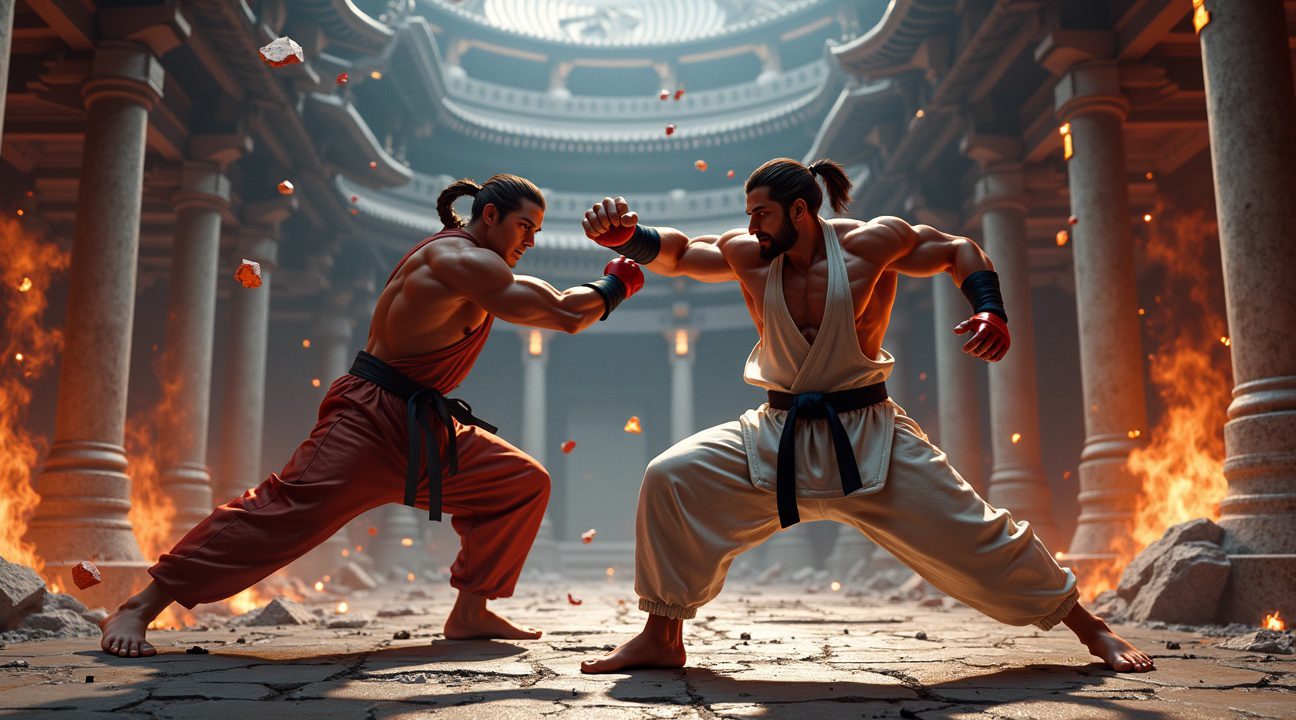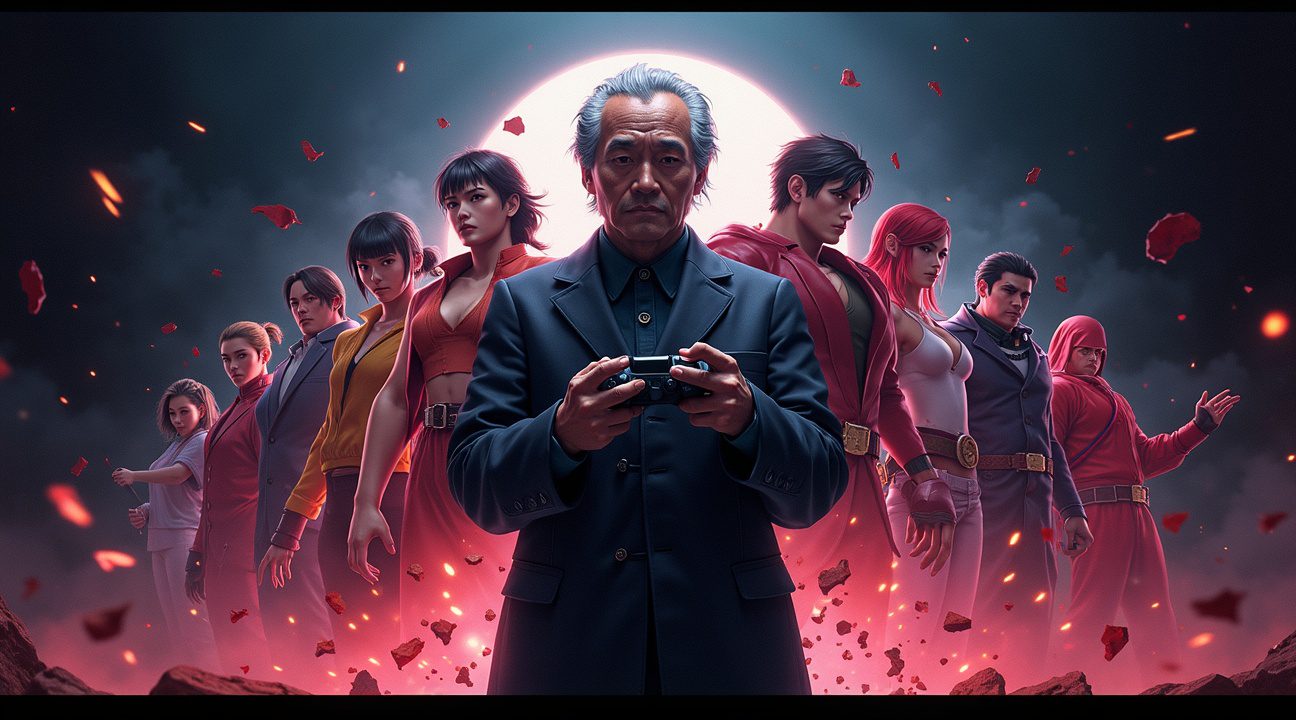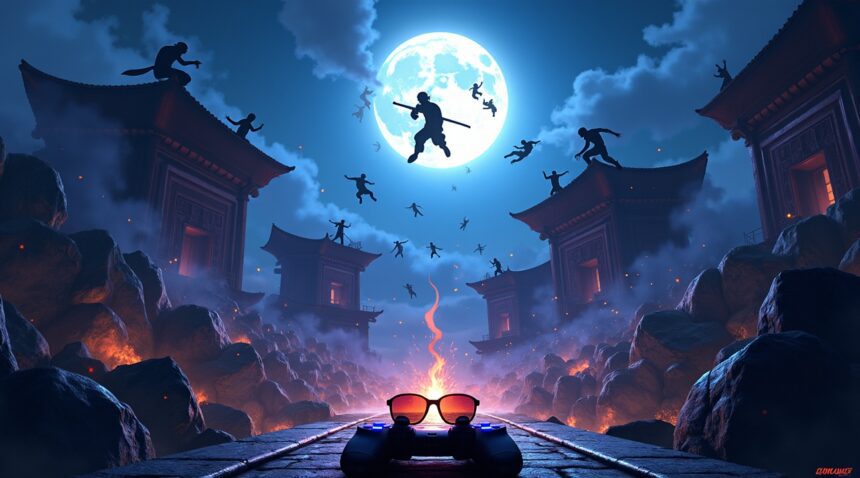Tomonobu Itagaki, the legendary game designer behind iconic franchises Dead or Alive and Ninja Gaiden, passed away at age 58 in October 2025, leaving the gaming industry in shock and mourning.
Key Takeaways
- Itagaki passed away at age 58 with the announcement coming through his official Facebook page, catching the gaming industry completely off guard with no prior indication of health issues.
- He revolutionized fighting games through innovations like the universal counter system in Dead or Alive and destructible multi-tiered environments that fundamentally changed combat mechanics.
- His career spanned over two decades at Team Ninja where he directed landmark titles including Dead or Alive 2-4, Ninja Gaiden Black, and Ninja Gaiden II that pushed technical boundaries and player skill requirements.
- After leaving Tecmo in 2008 following a legal dispute, he founded Valhalla Game Studios and released Devil’s Third in 2015, demonstrating his commitment to creative independence.
- His final message expressed regret over not delivering another new project to fans, reflecting the passion and dedication that drove his career-long commitment to innovative game design.
Legendary Game Designer Behind Dead or Alive and Ninja Gaiden Dies at 58
I must share the devastating news that shook the gaming industry in October 2025. Tomonobu Itagaki, the visionary developer behind some of gaming’s most iconic franchises, passed away at the age of 58. His death represents an immeasurable loss for the entire gaming community, leaving behind a legacy that revolutionized action games and fighting mechanics.
The announcement came through a farewell post on his official Facebook page, which gaming insiders quickly translated and confirmed. This social media revelation caught the industry completely off guard, as there had been no prior indication of health issues or other concerns. The original Japanese post served as the primary source of information, though it left many questions unanswered about the circumstances surrounding his passing.
Industry Response and Recognition
The gaming community’s response was immediate and overwhelming. Katsuhiro Harada, director of Tekken, expressed shock and sorrow upon learning of Itagaki’s death. His reaction reflected the sentiment shared across the industry, as developers, publishers, and gaming personalities took to social media to pay their respects.
The outpouring of tributes highlighted several key aspects of Itagaki’s influence:
- His revolutionary approach to character design and animation, particularly in fighting games
- The technical innovations he brought to action game mechanics
- His commitment to pushing graphical boundaries on various gaming platforms
- The lasting impact of his work on modern game development practices
Fans worldwide joined industry professionals in mourning the loss. Online forums, gaming communities, and social media platforms became gathering places for people to share memories of playing his games and discuss how his work influenced their own gaming experiences. Many pointed to specific titles that had shaped their understanding of what action games could achieve.
The cause of death remains undisclosed as of the latest reports. This lack of information has led to respectful speculation within the community, though most have focused their energy on celebrating his contributions rather than dwelling on the circumstances of his passing. Gaming journalists and industry analysts have chosen to honor his memory by examining his creative output and the lasting influence of his design philosophy.
Itagaki’s impact extends far beyond the specific titles he created. His approach to game development influenced an entire generation of designers who studied his methods for creating fluid combat systems and memorable characters. The technical achievements in his games often pushed console hardware to its limits, demonstrating what was possible with creative optimization and artistic vision.
His passing marks the end of an era for a particular style of game development that emphasized both technical excellence and artistic flair. The gaming industry has recognized this loss as significant not just for what he accomplished, but for the potential future innovations that will never come to fruition. Many developers have noted that his willingness to take creative risks inspired them to pursue ambitious projects in their own careers.
The immediate aftermath of the announcement saw gaming websites and publications preparing retrospective articles examining his career highlights. Industry events and conferences have begun planning tributes and memorial segments to honor his contributions. Several gaming museums have also announced plans to create exhibits showcasing his work and its influence on the medium.
As the gaming community continues to process this loss, his legacy remains firmly established through the countless players who experienced his games and the developers who learned from his innovations. The profound impact he had on action game design and character development will continue influencing new generations of creators for years to come.

Revolutionary Fighting Game Innovations That Changed the Industry
Pioneering Mechanics That Redefined Combat Systems
I witnessed firsthand how Itagaki transformed the fighting game landscape when Dead or Alive launched in 1996. The franchise didn’t simply follow existing formulas – it shattered conventions with groundbreaking mechanics that competitors scrambled to replicate. The universal counter system became one of gaming’s most influential innovations, allowing players to reverse any attack with precise timing rather than relying on character-specific defensive options.
This revolutionary approach to defense created a dynamic flow that kept matches unpredictable. Players could no longer depend on repetitive attack patterns, as opponents always possessed the tools to turn defense into offense. The system’s elegance lay in its simplicity – a single button press could change the entire momentum of a fight.
Destructible environments added another layer of strategic depth that fighting games had never experienced. Walls crumbled under the force of combat, floors gave way beneath fighters’ feet, and multi-tiered stages created vertical battlegrounds. These environmental elements weren’t mere visual flourishes – they fundamentally altered how players approached each encounter.
The fluid animation system set new standards for character movement and visual fidelity. Characters moved with unprecedented naturalness, their attacks flowing seamlessly into defensive stances and evasive maneuvers. This attention to motion capture and animation detail influenced an entire generation of developers who recognized that visual polish directly impacted gameplay feel.
When Itagaki revitalized the Ninja Gaiden franchise in 2004, he brought these same innovative principles to action gaming. The Xbox release demonstrated how challenging gameplay could coexist with technical excellence, creating an experience that demanded mastery while rewarding skillful play. Critics praised the game’s uncompromising difficulty and precise controls, elements that became hallmarks of his design philosophy.
Contemporary fighting games continue to bear Itagaki’s influence in their approach to responsive controls and immersive gameplay mechanics. Modern titles regularly implement:
- Counter systems
- Environmental interactions
- Fluid animation techniques
These features trace their origins back to his pioneering work. Major studios study his games not just for nostalgic appreciation but for practical lessons in game design fundamentals.
The emphasis on innovation and originality that defined his career remains a guiding principle for current developers. Rather than following market trends, Itagaki consistently pushed boundaries and challenged player expectations. This philosophy inspired countless designers to prioritize creative risk-taking over safe, formulaic approaches.
Fighting game communities still discuss the lasting impact of his mechanical innovations decades after their introduction. The universal counter system appears in various forms across multiple franchises, while destructible environments have become standard features in many combat games. These elements prove that truly revolutionary ideas transcend their original implementations to become industry foundations.
His technical achievements in animation and visual presentation raised the bar for what players expected from fighting games. The fluid character movement and detailed environmental destruction showcased how technical excellence could enhance gameplay rather than merely serve aesthetic purposes. This integration of form and function became a template that developers still follow today.
The influence extends beyond fighting games into broader action and combat genres. Modern titles regularly incorporate elements that originated in his work, from responsive control schemes to challenging but fair difficulty curves. His approach to game design – prioritizing player skill development while maintaining accessibility – continues to shape how developers balance challenge with enjoyment.
Major studios recognize that innovation requires the courage to abandon established conventions, a lesson Itagaki demonstrated throughout his career. His willingness to experiment with new mechanics and challenge player expectations created a legacy that extends far beyond any single franchise or game release. The industry lost not just a talented developer but a visionary who consistently pushed the medium forward through bold creative choices and technical excellence.
The gaming industry continues to benefit from the foundations he established, with new generations of developers building upon his innovative approaches to create increasingly sophisticated and engaging combat systems.

Complete Career Spanning Over Two Decades at Team Ninja
Tomonobu Itagaki’s journey in game development began in 1992 when he joined Tecmo, initially contributing to the Super Famicom version of Tecmo Super Bowl. This early work laid the foundation for what would become one of the most influential careers in fighting and action game development. His ascent through the company ranks eventually led him to spearhead Tecmo’s premier development division, Team Ninja, where he would remain at the helm for more than 16 years.
Defining Titles That Shaped Fighting Game Culture
Itagaki’s directorial vision manifested through a series of groundbreaking titles that redefined player expectations. His portfolio includes several landmark releases that demonstrate his evolution as a developer:
- Dead or Alive 2 (1999) – Established the franchise’s signature multi-tiered fighting environments
- Dead or Alive 3 (2001) – Pushed technical boundaries on the original Xbox platform
- Dead or Alive 4 (2005) – Introduced online multiplayer capabilities to the series
- Ninja Gaiden Black (2005) – Delivered punishing difficulty that became legendary among action game enthusiasts
- Ninja Gaiden II (2008) – Showcased visceral combat mechanics that influenced the entire genre
Each title reflected Itagaki’s commitment to pushing both technical limits and player skill requirements. His games consistently demanded precision from players while delivering visual spectacles that showcased cutting-edge graphics technology. The Dead or Alive series particularly stood out for its interactive environments, where fighters could knock opponents through multiple levels of destructible scenery.
The Rock Star Developer Persona
Itagaki cultivated a distinctive public image that set him apart from his contemporaries in the gaming industry. His trademark sunglasses became an instantly recognizable symbol, though their origin story reveals a more practical beginning. Originally worn to conceal emotions while gambling, these dark shades evolved into an iconic part of his identity that reinforced his rock star developer status.
His outspoken nature extended beyond personal branding to industry commentary, particularly his vocal criticism of rival franchises like Tekken. These public statements generated considerable media attention and sparked debates among fighting game communities. While some viewed his comments as provocative marketing tactics, others appreciated his willingness to articulate strong opinions about game design philosophy and industry direction.
This combination of technical excellence and media savvy helped establish Itagaki as one of gaming’s most recognizable figures. His approach demonstrated how developers could build personal brands that transcended individual game releases, creating lasting connections with both press and players. The strategy proved effective in maintaining Team Ninja’s visibility throughout multiple console generations.
Itagaki’s influence extended beyond his own productions to shape broader industry trends. His emphasis on spectacle and technical achievement inspired other developers to pursue similar approaches in their own projects. The legacy of his work continues to influence modern fighting games, particularly in areas like environmental interaction and visual presentation.
Throughout his tenure at Team Ninja, Itagaki consistently delivered games that challenged conventional wisdom about what players wanted from interactive entertainment. His willingness to create demanding experiences that respected player intelligence helped establish a dedicated fanbase that continues to celebrate his contributions to gaming culture. The impact of his career at Team Ninja remains evident in contemporary game development, where his influence on action and fighting game design continues to resonate. Much like how Olivia Newton-John passes away at age 73 marked the end of an era in entertainment, Itagaki’s passing represents a significant loss for the gaming industry.
Founding Valhalla Game Studios After High-Profile Tecmo Exit
Itagaki’s departure from Tecmo in 2008 marked a pivotal moment in his career, stemming from a contentious legal battle over unpaid bonuses. The dispute highlighted his unwavering commitment to fair compensation for creative work and set the stage for his next chapter as an independent developer.
Following his exit, Itagaki established Valhalla Game Studios, driven by a desire to pursue his creative vision without corporate constraints. This move represented more than a career change—it embodied his philosophy that authentic game development required complete creative control. Through Valhalla, he aimed to demonstrate that technical excellence and innovative gameplay could thrive outside the traditional publisher system.
Devil’s Third and Creative Independence
The studio’s flagship project, Devil’s Third, launched in 2015 and served as Itagaki’s statement of creative independence. While the title garnered mixed reviews from critics, it showcased his willingness to experiment beyond the established franchises that had defined his earlier success. The game blended action elements with online multiplayer components, reflecting his ongoing interest in pushing gameplay boundaries.
Devil’s Third represented a calculated risk for Itagaki, demonstrating his commitment to exploring new creative territories rather than relying on past successes. The game’s reception illustrated the challenges independent developers face when competing against larger studios, yet it reinforced his dedication to authentic game development.
Throughout this phase, Itagaki maintained his core development principles, prioritizing technical prowess and polished gameplay experiences over market trends. His approach at Valhalla continued to emphasize the importance of craftsmanship in game development, mirroring the dedication that had characterized his work throughout his career. This period demonstrated that his influence on the gaming industry extended beyond individual titles, much like how other entertainment figures have left lasting impacts, as seen when Olivia Newton-John passes away at age 73.
Final Message to Fans and Lasting Creative Legacy
In his final public message, Tomonobu Itagaki expressed deep regret over not being able to release another new project, stating, “I just feel so sorry to all my fans for not being able to deliver my new work.” This heartfelt apology reflected the dedication he maintained throughout his career, always prioritizing his connection with players who eagerly anticipated each new creation. His words demonstrated the passion that drove him to push boundaries in game design until the very end.
A Distinctive Design Philosophy
Itagaki’s design philosophy set him apart from others in the industry, with an emphasis on bold creativity and fine-tuned technical execution. He consistently challenged conventional approaches to game development, refusing to follow trends or compromise his artistic vision for commercial appeal. His approach combined aggressive innovation with precise attention to gameplay mechanics, creating experiences that felt both fresh and polished.
The developer’s unwavering commitment to quality often extended development cycles, but players consistently praised the results. He believed that games should evoke strong emotional responses, whether through intense combat sequences or stunning visual presentations. This philosophy shaped every project he touched, from early arcade releases to major console exclusives.
Enduring Contributions to Gaming
His legacy endures through his contributions to the action and fighting game genres, fundamentally changing how developers approach combat systems and player interaction. Itagaki pioneered several key innovations that continue to influence modern game design:
- The universal counter system that allowed players to reverse attacks and maintain offensive momentum
- Destructible environments that added strategic depth and visual spectacle to combat encounters
- Fast-paced action mechanics that emphasized skill-based gameplay over button mashing
- Refined game mechanics that balanced accessibility with competitive depth
- Dynamic camera systems that enhanced the cinematic quality of combat sequences
These innovations didn’t emerge in isolation but represented a cohesive vision for what action games could become. Each element worked together to create experiences that felt more dynamic and engaging than previous generations of similar titles.
As a central figure in modern Japanese game development, Itagaki influenced a generation of developers who continue to uphold his innovative spirit. His mentorship and leadership at Team Ninja created a development culture that valued creative risk-taking and technical excellence. Many developers who worked under his guidance went on to lead their own projects, carrying forward his principles of bold design and player-focused development.
The impact of his work extends beyond specific game mechanics to broader industry practices. His emphasis on creating memorable characters and engaging narratives helped elevate action games from simple combat exercises to compelling entertainment experiences. Studio heads and creative directors across the industry still reference his approaches when discussing how to balance innovation with commercial viability.
Current game developers frequently cite Itagaki’s work when explaining their own design choices, particularly in how they approach combat systems and character development. His influence appears in contemporary titles that prioritize fluid movement, responsive controls, and visually striking presentation. The standards he established for action game quality continue to serve as benchmarks for new releases.
His passing represents the loss of a visionary who consistently pushed the medium forward, but his creative DNA lives on through the countless developers he inspired and the gaming conventions he helped establish. The techniques and philosophies he championed remain relevant as new generations of creators seek to craft engaging interactive experiences. His dedication to excellence and willingness to take creative risks serve as enduring examples for anyone working in game development.
The industry’s collective mourning reflects not just the loss of a talented individual, but recognition of how profoundly his work shaped modern gaming. His final message to fans captures the essence of what made him special: an unwavering commitment to delivering exceptional experiences to those who supported his creative journey.

Sources:
Economic Times: “Tomonobu Itagaki dies at 58: Is the cause of death known for the Ninja Gaiden and Dead or Alive creator?”
Game Developer: “Dead or Alive creator Tomonobu Itagaki, 58 passes away”
IMDb: Tomonobu Itagaki profile
Dead or Alive Wiki – Fandom: Tomonobu Itagaki


